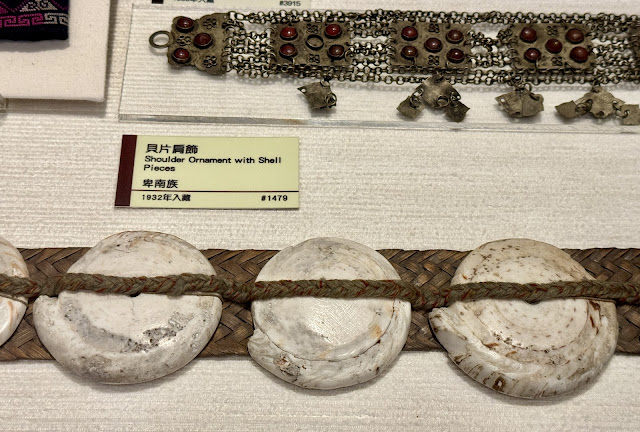Full-Blooded Han Chinese Becoming Indigenous Leaders (17-20th century)
 |
| Puyuma 卑南 Precious Beads and Corals @National Taiwan University (Update at the end 9/14/2025 Atayal) I first learned from a Taiwan Old-Family friend about Matreli 馬智禮 (a legendary Puyuma leader) was in fact born a full-blooded Hokkien Chinese who escaped to Taiwan with his father at age of four. My friend was going to contact Matreli's grandson 馬來盛 (who was named in honour of Matreli's father 朱來盛 ) prior to our Hualien-Taitung trip asking if he would be interested in meeting us. 馬來盛 declined. For maybe a year or so, I had thought Matreli was the first (and only) full-blooded Han Chinese who made his way to Taiwan and rose to become an indigenous tribal leader. While exploring Saisiyat's complicated migration route and history, I noticed something odd and soon 日阿拐 (basi-Banual) was brought to my attention. It looks like akuwai (nickname, born a Hokkien 張), instead of Matreli, was the first. Not only the dig-out of this early 20th century Han Chinese connection is 'unusual' - I also, in the meantime, identified 25 plus Fujian-Shinchiku (Hsinchu Prefecture) matching place names from a Japanese map (the fact that Miaoli was included in Hsinchu suggest the map was after 1920). A few months ago - I saw in Kaim Ang's 翁佳音 article that there were Han Chinese 頭目(boss) in Tsou/Bunun society in the 17th century. That was something extraordinary I thought because that pushed the said history further back by 200 years. Here is a brief summary of the above - 1. Tsou/Bunun Society Dutch-Formosa 17th Century I, however, managed to find a substitute which I believe covered the relevant information and details. Combined with other reading (online) such as - Inherited Geography: Post-national History and the Emerging Dominance of Pimaba in East Taiwan. 2005 Peter Kang 由荷治時期記載Arissang社-兼論清代的唣囉婆社 (1646) Through the descriptions, I was drawn to think - although there appeared no identification of particular Han Chinese names and persons. In order to make things worked among the three tribes - Dutch, The Indigenous, Han Chinese during Dutch-Formosa period, the powerful Chinese presence and leadership appeared an inevitable and necessary outcome. Having said that whether there was specific person details on DZII p470. I don't know. 2. Saisiyat 日阿拐 (basi-Banual. akuwai) (1840~1903) Born to a Hokkien 張 family. Came to Taiwan at age of 8. Sold to (Adopted by) Plains Saisiyat 日 clan. Saisiyat name '日張 Tanohila' combines the two names. hahila is sun 日. 'Tan' I reckon is a prefix represents '張 Zhang' - akuwai's birth family. In addition, I identified 25 plus matching place names between Fujian and Hsinchu prefecture (map should be after 1920). 3. Puyuma-
Matreli 馬智禮
(1887 -1966 ) Matreli's father 朱來盛 fled 'clan massacre' in their Fujian hometown. Took Matreli at age of four, and eventually settled with the Puyuma in Taitung. 'Rebel Island' by Jonathan Clements page 176 covers Matreli's legendary collaboration skills, and keep-peace tactics. Relevant Information - Becoming Indigenous Blogpost |
Beads, Corals, Iron Pans, Cotton Trade during Dutch-Formosa
(Update 9/14/2025 Atayal)
Wulai - Han boy 林春成 (1896) brought up as indigenous and became Atayal chief.
‘Uatan Siat’ was born to Han parents in Wulai.
‘Uatan Siat’ was born to Han parents in Wulai.
Father ‘Siat Nomin’ was a Han from Xindian.
Uatan’s mother and sister were killed by Atayal during head-hunt expedition and was taken by the Atayal headhunters to be brought up under Atayal chief Yumin Lei.
Uatan Siat later inherited Yumin as Atayal chief- today’s 忠治 district.














Comments
Post a Comment